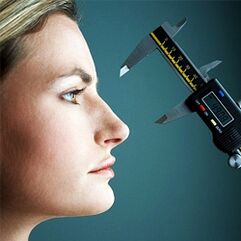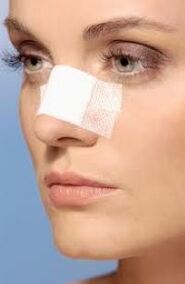The nose is the most visible part of the face and is the shape and general appearance that determines a person's perception by others. Many of us are dissatisfied with our nose: some do not like its size or shape, some suffer from a hump or very wide wings, and a third wants to fix the tip, which sticks to the tip of the nose or, conversely, hangs. . All these problems are solved in a very simple way with the help of one of the oldest plastic surgeries - rhinoplasty.
Rhinoplasty- surgery to correct (change) the shape or size of the nose, aimed at improving the appearance, as well as eliminating problems with nasal breathing and creating a psychologically comfortable situation for the patient.
Types of rhinoplasty
Make a distinction between aesthetic and reconstructive rhinoplasty.
The main purpose of aesthetic rhinoplasty is to correct the "mistake" of nature by changing the shape or size of the nose, and thus give the face a more harmonious and attractive appearance. Aesthetic rhinoplasty can be either complete or superficial (partial).
Complete rhinoplasty is a plastic operation in which the surgeon touches all the structural parts called the external nose: bone tissue, cartilage tissue and soft tissue. Such an operation is indicated for patients who want to reduce the length or width of the nose, change the shape of the saddle and remove the hump.
Partial (or superficial) rhinoplasty is an operation in which the surgeon corrects (changes) the shape of the nose without affecting the bone tissue, limited to working only some parts of the nose. If it is necessary to straighten the tip of the nose or reduce the wings, a partial rhinoplasty is performed, although a complete rhinoplasty may be required to eliminate such problems - this is decided by the doctor after examination and conversation with the patient.
Reconstructive rhinoplasty is primarily aimed at resolving a problem such as nasal curvature of the nasal septum or breathing difficulties due to hypertrophy of the turbines. Reconstructive rhinoplasty involves the repair of a nose injury, an injury (e. g. , a "lateral slip" due to a fracture), as well as a partial or complete loss due to an injury. This type of surgery is used if it is necessary to correct a congenital deformity of the osteochondral skeleton in the nasal region. Sometimes a plastic surgeon has to literally "sculpt" a new nose using the cartilage and artificial materials of headphones or caustic cartilage (especially in severe cases).
Often, the patient needs to be operated on, not for cosmetic or aesthetic purposes, but to restore normal breathing, which was disrupted due to deformation of the nasal septum obtained during the trauma. Typically, post-traumatic surgery includes nasal plastic surgery and septoplasty (surgery aimed at correcting the nasal septum, the main purpose of which is to restore normal nasal breathing).
We are preparing for rhinoplasty

Before deciding on an operation, the patient discusses future parameters and the appearance of the nose with the plastic surgeon, it turns out exactly what the patient wants to achieve, and the end result is simulated using a computer. This approach helps the patient to "try" a new nose on the face before surgery, so that the new look does not disturb the overall proportions of the face, and the shape of the nose blends harmoniously with all facial features.
We must not forget that rhinoplasty is not performed if the patient is under 17-18 years old. This is due to the growth of the body and the formation of cartilage and bone skeleton; The results of rhinoplasty at an early age can be unpredictable. However, it is preferable to seek rhinoplasty before the age of 21 - doctors say that the skeletal system has finally formed by this age.
Features of nasal correction surgery
Rhinoplasty is known as one of the most difficult plastic surgeries: it is important not only to change the nose and give it the desired size or shape, but also not to disturb the nasal breathing. Therefore, such an operation should be performed only by an experienced specialist who has proven himself and has good patient views.
Rhinoplasty can be performed with both open and closed access. The open entrance is surrounded by a leather incision on the outside and as a result is almost invisible. With a closed entrance, the surgical intervention is performed without any external incision from the edge of the nasal mucosa (nostrils) and leaves no trace. Closed rhinoplasty is considered more difficult and requires special skills of a plastic surgeon.
The type of speech is determined directly in the consultation and depends on many factors: the shape of the nose, the characteristics of the structure and the desired result. The operation is performed under or under local anesthesia to correct the size or shape of the nose. general anesthesia: the choice of anesthesia is influenced by the complexity of the surgical procedure and the duration of the proposed operation. In any case, the patient is completely relieved of pain and does not feel any discomfort.
Postoperative period

Rhinoplasty is a serious surgical procedure that requires not only a professional approach of the doctor, but also the patient's own responsibility during the rehabilitation period. The postoperative period is painless. Only in the first few days, tampons, which make it difficult to breathe through the nose, cause the patient a little discomfort.
For skin care of the nose, a fixed plaster cast is applied from time to time, it is usually mandatory to wear such a bandage for 7 to 10 days. During this period, the primary edema usually disappears and the bruises and puffiness under the eyes disappear. For others, the almost invisible residual subcutaneous induction disappears completely within 6-8 months. After this period, the final result of rhinoplasty will be visible.
As a rule, the patient is discharged the next day after surgery, but still remains under the supervision of a doctor who comes to the clinic for examination and dressing. The general healing process after rhinoplasty takes about a month, during which time the patient is advised to wear a special bandage on the nose, as well as to limit physical activity and eliminate harmful habits (smoking, alcohol consumption).
A patient undergoing rhinoplasty should undergo a mandatory examination by a plastic surgeon 3, 6 and 12 months after the operation.
Contraindications to rhinoplasty
An experienced plastic surgeon will refuse to perform the operation if the patient has previously had the following diseases.
- diseases of the cardiovascular system;
- blood clotting disorders;
- chronic diseases of the liver and kidneys in the acute stage;
- oncological diseases;
- infectious diseases;
- mental illness.
Of course, rhinoplasty is a serious step in the life of a person who dreams of changing his nose and at the same time his life. But most of us understand perfectly well: if there are - even significant - figure flaws that can be "masked" with the help of clothes or even turned into advantages, then an ugly nose is the first thing that others notice when looking at the face. And if this nose is too big or crooked, such a "spectacle" can not be hidden in any way, it will always spoil the look and mood. For this reason, sometimes you have to decide on surgery and correct the shape or size of your nose instead of breathing and suffering for the rest of your life when you look in the mirror.




















